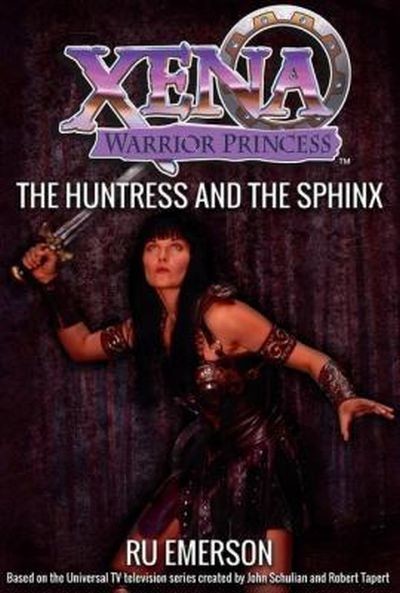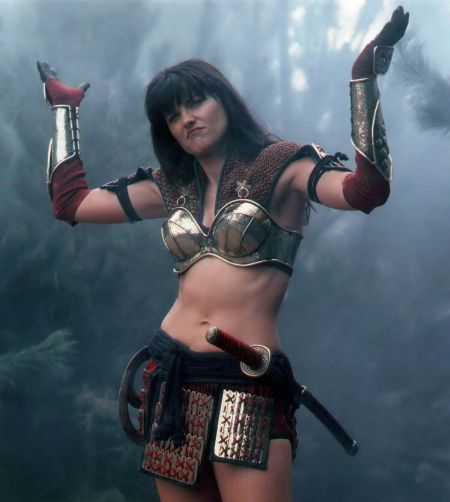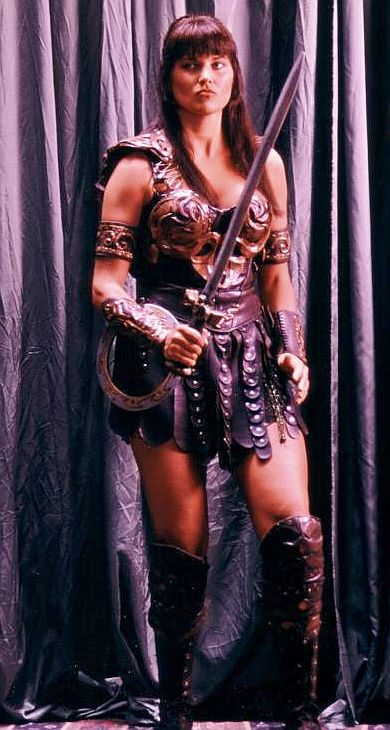 Well, it was a glorious 24 hours of hope, while it lasted. On Monday, the Hollywood Reporter wrote that NBC were “in the extremely early development stages” of preparing a reboot of the much-loved action-heroine series, which originally began in 1995. Producers of the original show, Rob Tapert and Sam Raimi, were reportedly involved, continuing a partnership which had also brought us Spartacus and the upcming Ash vs. Evil Dead – both of which included roles for Lucy Lawless, a.k.a. Mrs. Tapert. There was no firm word as to whether Lawless would have been involved in the reboot, but based on that track record, it would seem likely. Albeit not as the heroine, the piece saying “the new Xena would have to have the charisma and charm of Lawless and the smarts of The Hunger Games‘ Katniss as producers are said to be looking for a sophisticated and smart superhero for a new generation.”
Well, it was a glorious 24 hours of hope, while it lasted. On Monday, the Hollywood Reporter wrote that NBC were “in the extremely early development stages” of preparing a reboot of the much-loved action-heroine series, which originally began in 1995. Producers of the original show, Rob Tapert and Sam Raimi, were reportedly involved, continuing a partnership which had also brought us Spartacus and the upcming Ash vs. Evil Dead – both of which included roles for Lucy Lawless, a.k.a. Mrs. Tapert. There was no firm word as to whether Lawless would have been involved in the reboot, but based on that track record, it would seem likely. Albeit not as the heroine, the piece saying “the new Xena would have to have the charisma and charm of Lawless and the smarts of The Hunger Games‘ Katniss as producers are said to be looking for a sophisticated and smart superhero for a new generation.”
This was certainly something Lawless had been keen on for quite some time. Just earlier this month, while appearing at San Diego Comic-Con to promote Ash vs. Evil Dead, she said: ” I’m pitching my ass off to make it happen, whether it’s with me or not… It’s about who’s got the rights. But that’s a piss poor excuse anymore… Freakin’ pay it. It’s better to have 80 percent of something than 100 percent of nothing. Don’t waste this opportunity. Reinvigorate that franchise… They’re fools not to bring it back.” Judging by the reaction in the media, Lawless is right: the demand for a Xena revival is clearly still there, and it wouldn’t be the only piece of fondly-remembered nineties television, with the Fox revival of The X-Files already being one of the most eagerly anticipated shows of 2016.
But, not so fast, those of you already strapping on the leather corset in preparation for the cosplay contest at XenaCon next year. For no sooner had the seed been planted, then the earth on which it was sown was strewn with cruel salt:
Sorry, friends! news of a #Xena reboot is just a rumor. I’d love it to happen one day but it’s still in the wishful thinking stage.
— Lucy Lawless (@RealLucyLawless) July 20, 2015
Pardon me, if I sob gently into my Gabrielle-shaped pillow for a bit. :) Though it’s kinda odd, because the Reporter piece definitely seemed like it was a good deal more than a “rumor”, with meat on its bones, though did acknowledge the development was still in the extremely early stages. One wonders whether the story was, perhaps, a trial balloon of sorts, sent up to see whether the public were enthusiastic about the potential, or whether it was greeted with derisive rolling of the eyes. That question seems to have been answered in the positive, and it would certainly fill a niche for action-heroines on network television, which right now appears virtually to begin and end with Agent Carter and Covert Affairs. But let’s not forget, NBC are also the network which got as far as the Wonder Woman pilot, with Adrienne Palicki, and that never even (officially) aired. There’s many a slip ‘twixt cup and lip.
If the idea does progress, the issue could then become one of casting. There is, obviously, a strong groundswell of support from the existing fanbase to have Lawless and Renee O’Connor [who has been quiet on the whole thing] reprise their roles, even though they are aged 47 and 44 respectively. While not “past it” – Vin Diesel, say, is 48, or the Rock is 43 – this is a full two decades older than they were when they started the series. Lawless has acknowledged this, saying she thinks it’d be funny for the reboot to have a “middle-aged Xena in a muumuu with a bad attitude and a smoking habit.” Hmm. It might be funny as a one-0ff, but not sure there is exactly much staying power in that idea! Who I would like to see take over, and it would also provide a nice sense of continuity, is Zoe Bell, who was Lawless’s stunt stand-in in the show. Performances in the like of Raze have shown her capable of holding her own on the screen; and think of the money they’d save in doubles…
We’ll see what develops. I’d like to see it, but have to say, my re-viewing of the series has been a bit like binge-watching Monty Python: yes, there were some absolute classics, but your brain kinda forgets all the filler and other, lower-quality stuff in between those gems. The potential is there, sure, yet also the potential for a fond memory of my younger days to be shredded. For an example, look no further than the Charlie’s Angels reboot? Enough said.






 I used to be a Xena fan; for the first couple of series, I was a die-hard, never missed an episode, bought the merchandise, went to the gatherings, etc. I loved (with one exception) the supporting cast – Joxer, Ares, Autolycus – and still reckon Callisto remains one of the great TV villainesses of all time.
I used to be a Xena fan; for the first couple of series, I was a die-hard, never missed an episode, bought the merchandise, went to the gatherings, etc. I loved (with one exception) the supporting cast – Joxer, Ares, Autolycus – and still reckon Callisto remains one of the great TV villainesses of all time.
 The defining moment of Xena’s sophomore season didn’t take place in any episode. In fact, it didn’t even take place in New Zealand, but thousands of miles away, During a rehearsal for an appearance on The Tonight show with Jay Leno, Lucy Lawless was thrown off a horse after it lost its footing, and broke her pelvis. It’s interesting to compare the reaction of the producers to what the Tapert/Raimi team did when the star of Spartacus, Andy Whitfield, was similarly a victim of severe misfortune, more than a decade later. There, they put the show entirely on hold and opted instead to film a prequel without him.
The defining moment of Xena’s sophomore season didn’t take place in any episode. In fact, it didn’t even take place in New Zealand, but thousands of miles away, During a rehearsal for an appearance on The Tonight show with Jay Leno, Lucy Lawless was thrown off a horse after it lost its footing, and broke her pelvis. It’s interesting to compare the reaction of the producers to what the Tapert/Raimi team did when the star of Spartacus, Andy Whitfield, was similarly a victim of severe misfortune, more than a decade later. There, they put the show entirely on hold and opted instead to film a prequel without him. In terms of style and approach, the show covers even more ground here than the first time, from absolutely froth to grim darkness. Xena even gets crucified by Julius Caesar in one episode [confusingly, the actor responsible also crops up later, playing Cupid, complete with fluffy wings…]. I’m sure I’m not the only one who found themselves whistling Always Look on the Bright Side of Life, during the scene shown above right. Another unwitting Python reference is the wretched Here She Comss, Miss Amphipolis, a dreadful tale of drag-queen empowerment, featuring perhaps the least convincing female impersonator since John Cleese put on a dress – as on the left, watch that Adam’s apple
In terms of style and approach, the show covers even more ground here than the first time, from absolutely froth to grim darkness. Xena even gets crucified by Julius Caesar in one episode [confusingly, the actor responsible also crops up later, playing Cupid, complete with fluffy wings…]. I’m sure I’m not the only one who found themselves whistling Always Look on the Bright Side of Life, during the scene shown above right. Another unwitting Python reference is the wretched Here She Comss, Miss Amphipolis, a dreadful tale of drag-queen empowerment, featuring perhaps the least convincing female impersonator since John Cleese put on a dress – as on the left, watch that Adam’s apple  It’s assumed viewers are at least somewhat familiar with Xena’s background, as she is first seen burying her armour in an effort to bury her past. Of course, this is about as successful as it usually is in fiction, and it’s not long before she’s saving villagers, including Gabrielle, from slavery. That includes an aerial battle atop platforms, which is the first sign of the show’s strong influence from Hong Kong action films; it was using wirework, in a way that predated its popular arrival in Hollywood. Similarly, the stunning New Zealand locations foreshadow Lord of the Rings, to the extent that I kept expecting to see hobbits gamboling along in Xena’s wake.
It’s assumed viewers are at least somewhat familiar with Xena’s background, as she is first seen burying her armour in an effort to bury her past. Of course, this is about as successful as it usually is in fiction, and it’s not long before she’s saving villagers, including Gabrielle, from slavery. That includes an aerial battle atop platforms, which is the first sign of the show’s strong influence from Hong Kong action films; it was using wirework, in a way that predated its popular arrival in Hollywood. Similarly, the stunning New Zealand locations foreshadow Lord of the Rings, to the extent that I kept expecting to see hobbits gamboling along in Xena’s wake.
 Xena is one of the definitive action-heroine shows of all time. Originally appearing as a supporting character in a three-episode story arc on Hercules: The Legendary Journeys, in which she abandons her life as a warlord and opts instead to fight for good, as a way of making amends for her life. The producers opted to develop her as a spin-off, and the show ran for six seasons between 1995 and 2001, ending in a two-part finale (the review of which, below, was written first, hence it somewhat duplicates the overview here). It proved highly-popular for a show with no designated network home, pulling an audience in syndication of up to 7.8 million viewers during its second season, and inspiring a devoted fanbase that persists, even a decade after the show has come to an end.
Xena is one of the definitive action-heroine shows of all time. Originally appearing as a supporting character in a three-episode story arc on Hercules: The Legendary Journeys, in which she abandons her life as a warlord and opts instead to fight for good, as a way of making amends for her life. The producers opted to develop her as a spin-off, and the show ran for six seasons between 1995 and 2001, ending in a two-part finale (the review of which, below, was written first, hence it somewhat duplicates the overview here). It proved highly-popular for a show with no designated network home, pulling an audience in syndication of up to 7.8 million viewers during its second season, and inspiring a devoted fanbase that persists, even a decade after the show has come to an end. There was enormous, often ferocious debate among fandom over the nature of Xena and Gabrielle’s relationship, some asserting they were a lesbian couple. While both showed plenty of evidence of heterosexuality, there was a lot of content open to interpretation – much of it absolutely deliberate, and known as “subtext” in Xena fandom. I never found it convincing. My issue with it was not one of sexuality, simply compatibility: Xena and Gabrielle were absolute opposites, in background, upbringing, personality and approach. They just didn’t “fit” each other, from what I could see, and there was no chemistry visible. Xena and Hercules: I could see that. Xena and the Queen of the Amazons: no problem there either. But Xena and Gabrielle? Sorry. Not buying this. It also played into the stereotype that any strong woman
There was enormous, often ferocious debate among fandom over the nature of Xena and Gabrielle’s relationship, some asserting they were a lesbian couple. While both showed plenty of evidence of heterosexuality, there was a lot of content open to interpretation – much of it absolutely deliberate, and known as “subtext” in Xena fandom. I never found it convincing. My issue with it was not one of sexuality, simply compatibility: Xena and Gabrielle were absolute opposites, in background, upbringing, personality and approach. They just didn’t “fit” each other, from what I could see, and there was no chemistry visible. Xena and Hercules: I could see that. Xena and the Queen of the Amazons: no problem there either. But Xena and Gabrielle? Sorry. Not buying this. It also played into the stereotype that any strong woman